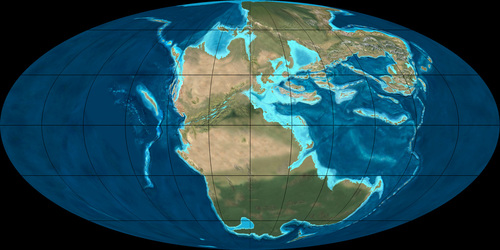
In the late Triassic period, 220 million years ago (220 mya), all the continents formed a single land mass called Pangaea.
Geologists have been able to reconstruct what the Earth would have looked like in prehistoric times. 220 million years ago, when dinosaurs first evolved, the Earth looked very different: the Americas, Africa, Antartica, India and Australia were all joined together in a single super-continent called Pangaea. Over millions of years they separated and moved their separate ways across the globe.
At different times the continents have been in different climactic zones of the planet. At one time India was near the South Pole and was covered in glaciers[1]; Antartica has fossils that could only have lived in tropical zones[2]. The configuration of the continents has also directly affected the climate, altering ocean currents and wind patterns. The conglomeration of continents over the South Pole 650 million years ago may have caused large-scale glaciation across the planet in a scenario known as Snowball Earth[3].
This also means that plate tectonics has had a huge effect on the evolution of life, both by altering the climate and by geographically isolating species during their evolution.[4]
All of these different aspects will be explored in further slideshows.
India would have been partially covered in glaciers several times, including during Snowball Earth 650 mya and 300 mya when Gondwana glaciated. Refs?
450 mya Antartica would have been near the equator [Wikipedia: Geology of Antarctica].
Wikipedia: Snowball Earth may have triggered the Cambrian explosion in diversity of multi-cellular life.
Note that life has also altered geology. Some examples are the production of oxygen in the atmosphere and the laying down of chalk and limestone rocks formed from the compressed shells of marine organism.
Author: Tom Brown
Copyright: public domain
Date last modified: 11th Oct 2011
Peer-review status: Not yet peer-reviewed
Continents over time: source: here, reused on Wikipedia